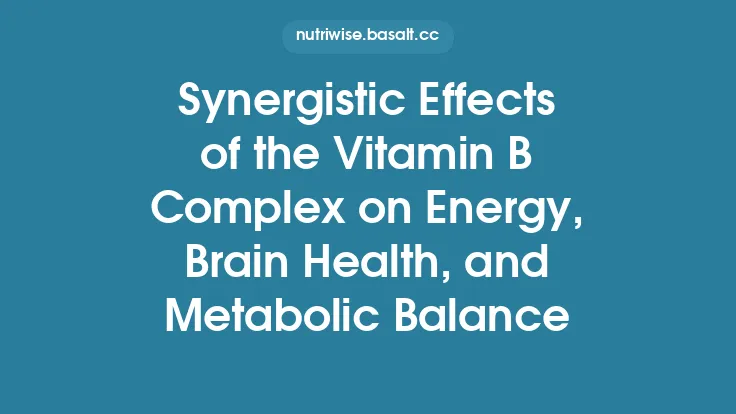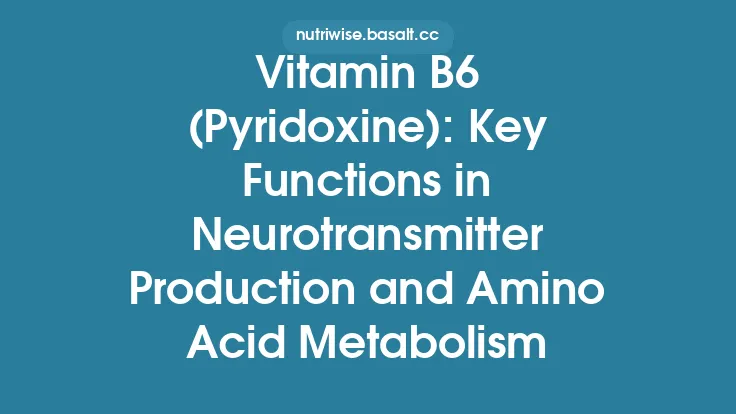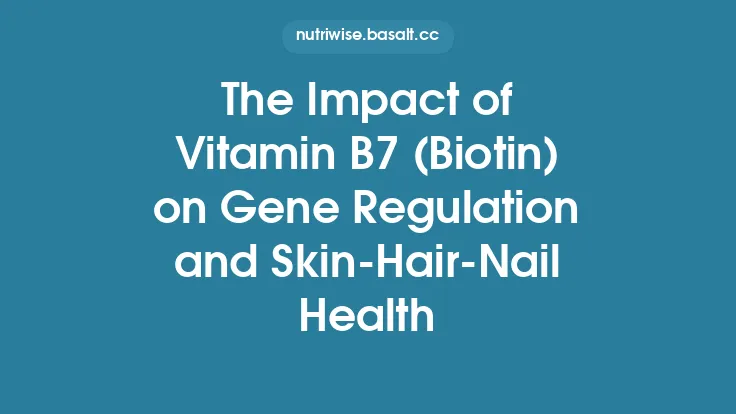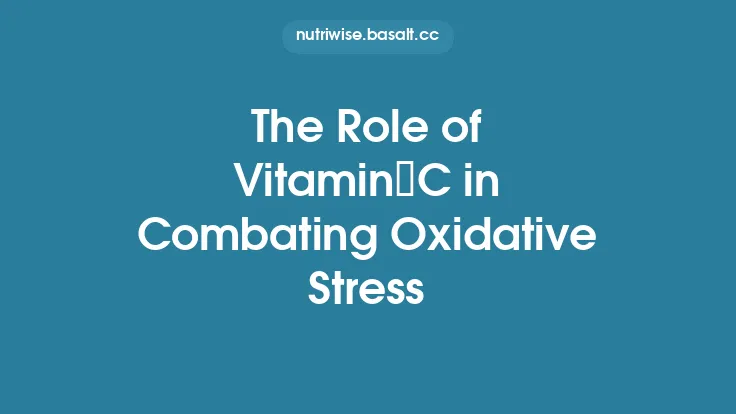Vitamin B1, known scientifically as thiamine, is a water‑soluble micronutrient that sits at the very heart of cellular energy metabolism. Though required only in milligram quantities, its impact on the body’s ability to convert the food we eat into usable adenosine‑triphosphate (ATP) is profound. Without adequate thiamine, the biochemical pathways that break down carbohydrates, fats, and proteins become bottlenecked, leading to reduced energy output, accumulation of metabolic intermediates, and, over time, clinical syndromes such as beriberi and Wernicke‑Korsakoff disorder. This article explores the essential functions of thiamine in energy production, detailing its biochemical roles, physiological importance, dietary sources, and practical considerations for maintaining optimal status.
The Biochemical Foundations: Thiamine‑Dependent Enzymes
Thiamine exerts its biological activity after conversion to the active coenzyme thiamine diphosphate (ThDP), also called thiamine pyrophosphate (TPP). ThDP serves as a cofactor for several key enzymes that drive the flow of carbon through central metabolic pathways:
| Enzyme (ThDP‑dependent) | Primary Metabolic Pathway | Core Reaction |
|---|---|---|
| Pyruvate Dehydrogenase Complex (PDH) | Linkage of glycolysis to the citric acid cycle | Decarboxylation of pyruvate to acetyl‑CoA |
| α‑Ketoglutarate Dehydrogenase Complex (α‑KGDH) | Citric acid cycle (TCA) | Decarboxylation of α‑ketoglutarate to succinyl‑CoA |
| Branched‑Chain α‑Keto Acid Dehydrogenase (BCKDH) | Catabolism of branched‑chain amino acids (leucine, isoleucine, valine) | Oxidative decarboxylation of branched‑chain keto acids |
| Transketolase | Pentose Phosphate Pathway (non‑oxidative branch) | Transfer of two‑carbon units between sugars |
These enzymes are indispensable for extracting high‑energy electrons from nutrients and funneling them into the mitochondrial electron transport chain, where ATP synthesis occurs. A deficiency in thiamine directly impairs each of these steps, leading to a cascade of metabolic disturbances.
From Glucose to ATP: Thiamine’s Role in Carbohydrate Metabolism
- Glycolysis Completion
Glycolysis ends with the production of pyruvate, a three‑carbon molecule. In the presence of adequate oxygen, pyruvate must be converted into acetyl‑CoA to enter the citric acid cycle. This conversion is catalyzed by the PDH complex, which requires ThDP as a cofactor. Without thiamine, pyruvate accumulates and is shunted toward lactate production, contributing to lactic acidosis under stress.
- Citric Acid Cycle (TCA) Continuity
Within the TCA cycle, α‑KGDH catalyzes the conversion of α‑ketoglutarate to succinyl‑CoA, a step that releases NADH and CO₂. ThDP deficiency stalls this reaction, causing a bottleneck that reduces the generation of NADH and FADH₂—critical electron donors for oxidative phosphorylation.
- Link to Oxidative Phosphorylation
The NADH and FADH₂ produced by PDH and α‑KGDH feed electrons into Complex I and II of the mitochondrial electron transport chain. The resulting proton gradient drives ATP synthase, producing the bulk of cellular ATP. Thus, thiamine indirectly sustains the final ATP yield from glucose oxidation.
Supporting Fat and Protein Utilization
While thiamine is most celebrated for its role in carbohydrate oxidation, its influence extends to the metabolism of fats and proteins:
- Fatty Acid Oxidation: The acetyl‑CoA generated by PDH is a substrate for the citric acid cycle, which in turn provides the oxaloacetate needed for the condensation of acetyl‑CoA derived from β‑oxidation. Impaired PDH activity reduces the capacity of the TCA cycle to handle acetyl‑CoA from fatty acids, diminishing overall energy output from lipid stores.
- Branched‑Chain Amino Acid Catabolism: BCKDH, a ThDP‑dependent enzyme, initiates the breakdown of leucine, isoleucine, and valine. Efficient catabolism of these amino acids supplies additional acetyl‑CoA and succinyl‑CoA, feeding the TCA cycle and supporting gluconeogenesis during fasting.
The Pentose Phosphate Pathway: Thiamine’s Contribution to Redox Balance
Transketolase, another ThDP‑dependent enzyme, operates in the non‑oxidative branch of the pentose phosphate pathway (PPP). Although the PPP is often highlighted for its generation of NADPH (via the oxidative branch), the non‑oxidative branch is essential for:
- Ribose‑5‑Phosphate Production: Required for nucleotide synthesis, supporting cell proliferation and repair.
- Interconversion of Sugar Phosphates: Allows the cell to balance the needs for glycolytic intermediates and PPP substrates, especially under varying metabolic demands.
By facilitating these sugar‑phosphate rearrangements, thiamine indirectly supports the cell’s capacity to manage oxidative stress (through NADPH generated elsewhere) and to sustain biosynthetic processes that rely on ribose sugars.
Clinical Manifestations of Thiamine Deficiency: Energy‑Related Syndromes
When thiamine intake or utilization falls short, the energy‑producing pathways described above become compromised, leading to characteristic clinical pictures:
- Beriberi (Dry and Wet Forms)
- *Dry beriberi*: Peripheral neuropathy, muscle weakness, and wasting due to impaired neuronal energy metabolism.
- *Wet beriberi*: Cardiovascular manifestations such as tachycardia, high-output heart failure, and edema, reflecting the heart’s reliance on continuous ATP supply.
- Wernicke‑Korsakoff Syndrome
A neuropsychiatric disorder seen primarily in chronic alcohol misuse, where thiamine deficiency impairs cerebral glucose metabolism, leading to acute encephalopathy (Wernicke’s) and chronic memory deficits (Korsakoff’s).
These conditions underscore the indispensable nature of thiamine for maintaining adequate ATP production in both peripheral tissues and the central nervous system.
Dietary Sources and Bioavailability
Thiamine is abundant in a variety of whole foods, though its stability can be compromised by heat, alkaline conditions, and prolonged storage. Key sources include:
- Whole Grains and Cereals: Enriched wheat flour, brown rice, oats, and barley.
- Legumes: Lentils, black beans, and peas.
- Nuts and Seeds: Sunflower seeds, macadamia nuts.
- Animal Products: Pork (particularly lean cuts), liver, and fish.
- Yeast and Fermented Products: Nutritional yeast and certain breads.
Processing methods such as milling (which removes the bran) and refined grain production significantly reduce thiamine content. Therefore, consumption of minimally processed grains and fortified products helps ensure adequate intake.
Absorption, Transport, and Cellular Retention
- Intestinal Absorption
Thiamine is absorbed primarily in the jejunum via active transport mediated by the thiamine transporter 1 (THTR‑1, encoded by *SLC19A2*) and, at higher concentrations, by passive diffusion. Certain conditions—chronic alcoholism, gastrointestinal surgery, and inflammatory bowel disease—can impair this process.
- Plasma Transport
Once absorbed, thiamine circulates bound to albumin and is taken up by tissues through the same THTR‑1 and THTR‑2 (encoded by *SLC19A3*). The brain expresses high levels of THTR‑2, reflecting its sensitivity to thiamine status.
- Cellular Conversion
Inside cells, thiamine is phosphorylated by thiamine pyrophosphokinase (TPK) to form ThDP. This step is tightly regulated; excess ThDP is dephosphorylated back to thiamine for export or storage.
Recommended Intakes and Safety Considerations
| Population | Recommended Dietary Allowance (RDA)* |
|---|---|
| Adult men | 1.2 mg/day |
| Adult women | 1.1 mg/day |
| Pregnant women | 1.4 mg/day |
| Lactating women | 1.5 mg/day |
| Infants (0–6 mo) | 0.2 mg/day |
| Children (1–3 yr) | 0.5 mg/day |
\*Values are based on the Institute of Medicine (2020) guidelines and may vary slightly by country.
Thiamine has a low toxicity profile because excess amounts are excreted in urine. However, extremely high supplemental doses (e.g., > 500 mg/day) can cause rare adverse effects such as hypersensitivity reactions or, in some cases, interference with the absorption of other B‑vitamins. For most individuals, meeting the RDA through a balanced diet is sufficient.
Supplementation Strategies: When and How
- Targeted Populations
- Chronic alcohol consumers
- Individuals with malabsorption syndromes (celiac disease, bariatric surgery)
- Elderly adults with reduced gastric acidity
- Pregnant and lactating women (to meet increased demands)
- Formulations
- Thiamine hydrochloride: Standard water‑soluble form, readily absorbed.
- Benfotiamine: A lipid‑soluble derivative with higher bioavailability, often used in clinical research for diabetic complications (though its primary benefit lies outside pure energy metabolism).
- Thiamine mononitrate: Common in fortified foods and multivitamins.
- Timing
Taking thiamine with meals enhances absorption, especially when the diet includes carbohydrate‑rich foods that stimulate insulin release and increase cellular uptake.
Interactions with Other Nutrients and Medications
- Magnesium: Required as a cofactor for TPK, the enzyme that phosphorylates thiamine. Magnesium deficiency can therefore blunt thiamine activation.
- Alcohol: Inhibits thiamine absorption, impairs hepatic storage, and increases urinary excretion, creating a triple threat to thiamine status.
- Diuretics (e.g., furosemide): May increase renal loss of thiamine, necessitating monitoring in long‑term users.
- Antibiotics (e.g., tetracyclines): Can bind thiamine in the gut, reducing its bioavailability.
Understanding these interactions helps clinicians and nutrition professionals design comprehensive plans that safeguard thiamine status while addressing broader health needs.
Monitoring Thiamine Status
Direct measurement of plasma thiamine is possible but not routinely performed due to cost and variability. More practical approaches include:
- Erythrocyte Transketolase Activity (ETKA): Assesses the functional activity of thiamine‑dependent transketolase; a low activity indicates deficiency.
- Clinical Assessment: Evaluation of signs such as peripheral neuropathy, cardiac dysfunction, or neurocognitive changes in at‑risk individuals.
- Dietary Recall: Estimating intake through food frequency questionnaires or 24‑hour recalls, especially in populations with known risk factors.
Emerging Research: Thiamine and Mitochondrial Health
Recent investigations have highlighted thiamine’s role beyond classic enzymatic co‑factor functions:
- Mitochondrial Biogenesis: ThDP appears to influence the expression of peroxisome proliferator‑activated receptor gamma coactivator‑1α (PGC‑1α), a master regulator of mitochondrial replication.
- Reactive Oxygen Species (ROS) Modulation: By ensuring efficient flux through PDH and α‑KGDH, thiamine reduces the accumulation of partially oxidized metabolites that can generate ROS.
- Neuroprotective Effects: In experimental models of ischemic stroke, thiamine supplementation improves ATP recovery and limits neuronal death, underscoring its potential therapeutic value in acute energy crises.
While these findings are promising, they remain adjunctive to the core understanding that thiamine’s primary, evergreen contribution is to sustain the flow of carbon through energy‑producing pathways.
Practical Take‑aways for Maintaining Optimal Thiamine‑Driven Energy Production
- Prioritize Whole‑Grain and Legume Consumption – These foods deliver the highest natural thiamine densities.
- Limit Excessive Alcohol Intake – Alcohol directly impairs thiamine absorption and storage.
- Consider Fortified Foods – In regions where dietary patterns are low in thiamine, fortified cereals and breads can bridge the gap.
- Address Co‑factor Needs – Ensure adequate magnesium intake to support thiamine activation.
- Monitor At‑Risk Individuals – Use clinical signs and, where feasible, functional assays to detect early deficiency.
- Use Supplements Judiciously – Reserve high‑dose thiamine for documented deficiency or specific clinical scenarios; otherwise, a balanced diet suffices.
By anchoring cellular metabolism to the efficient operation of thiamine‑dependent enzymes, the body secures a reliable supply of ATP—the universal energy currency. Maintaining sufficient thiamine through diet, mindful lifestyle choices, and targeted supplementation when necessary ensures that the intricate biochemical machinery of energy production runs smoothly, supporting everything from muscle contraction to brain function. In the grand tapestry of micronutrients, Vitamin B1 stands out as a small but mighty catalyst for life‑sustaining energy.





